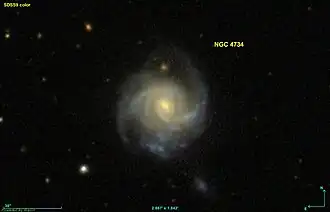NGC 4734
| NGC 4734 | |
|---|---|
 NGC 4734 imaged by Sloan Digital Sky Survey | |
| Observation data (J2000 epoch) | |
| Constellation | Virgo |
| Right ascension | 12h 51m 12.8847s[1] |
| Declination | +04° 51′ 32.244″[1] |
| Redshift | 0.025036 [1] |
| Heliocentric radial velocity | 7506 ± 2 km/s[1] |
| Distance | 376.9 ± 26.4 Mly (115.56 ± 8.10 Mpc)[1] |
| Apparent magnitude (V) | 13.5[1] |
| Characteristics | |
| Type | Sc?[1] |
| Size | ~135,600 ly (41.56 kpc) (estimated)[1] |
| Apparent size (V) | 1.0′ × 0.8′[1] |
| Other designations | |
| IRAS 12486+0507, 2MASX J12511286+0451320, UGC 7998, MCG +01-33-019, PGC 43525, CGCG 043-045[1] | |
NGC 4734 is a spiral galaxy in the constellation of Virgo. Its velocity with respect to the cosmic microwave background is 7835 ± 23 km/s, which corresponds to a Hubble distance of 115.56 ± 8.10 Mpc (~377 million light-years).[1] It was discovered by British astronomer John Herschel on 7 April 1828.[2]
The SIMBAD database lists NGC 4734 as a LINER-type active galaxy nucleus, i.e. a galaxy whose nucleus has an emission spectrum characterized by broad lines of weakly ionized atoms.[3]
One supernova has been observed in NGC 4734: SN 2024gvc (Type Ic, mag. 19.7178) was discovered by the Zwicky Transient Facility on 17 April 2024.[4]
See also
References
- ^ a b c d e f g h i j k "Results for object NGC 4734". NASA/IPAC Extragalactic Database. NASA and Caltech. Retrieved 7 August 2024.
- ^ Seligman, Courtney. "New General Catalogue Objects: NGC 4734". Celestial Atlas. Retrieved 16 December 2024.
- ^ "NGC 4734". SIMBAD. Centre de données astronomiques de Strasbourg. Retrieved 16 December 2024.
- ^ "SN 2024gvc". Transient Name Server. IAU. Retrieved 16 December 2024.
External links
 Media related to NGC 4734 at Wikimedia Commons
Media related to NGC 4734 at Wikimedia Commons- NGC 4734 on WikiSky: DSS2, SDSS, GALEX, IRAS, Hydrogen α, X-Ray, Astrophoto, Sky Map, Articles and images